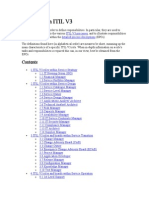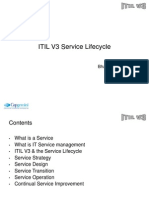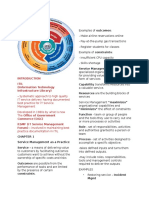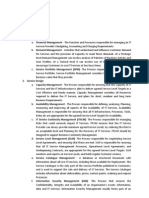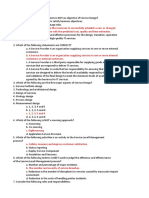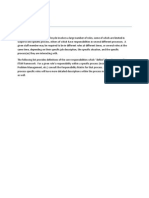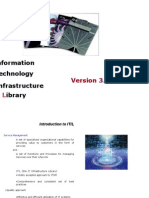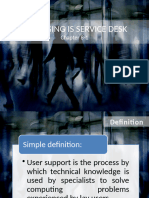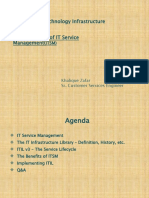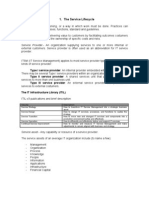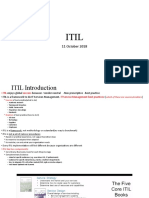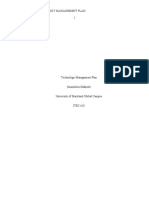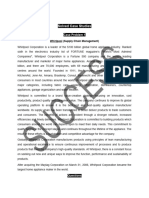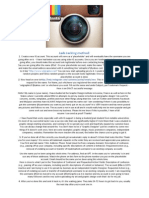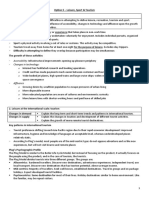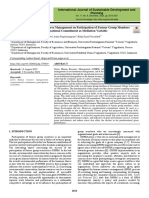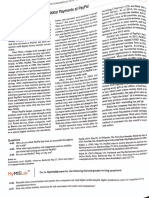Name:
Student Number:
Course Name: Service Design Management
Course code: IRM4811
Assignment 2
Due Date: 08 April 2020
Unique No: 853494
1
�Table of contents
Questions Page number
Question 1 4-5
Question 2 6-7
Bibliography 11
2
�Question 1
Evaluate the high-level roles that specifically support the ITSM service design
lifecycle stage and all the roles that support ITSM that are not specific to an ITSM
lifecycle stage
There are a set of roles that are specific to the ITSM service design lifecycle and some that are not
specific to the ITSM service design. Below we will discuss the roles and their function in ITSM service
design.
General IT Service Management Roles
These are high-level roles that are not specific to ITSM Lifecycle stage. They are still required in the
operation of IT Service management in an organization.
The IT Executives do governance and oversight of IT activities. The IT strategic direction and goals of
the organization is their responsibility, this includes making sure that all business processes are
followed and that compliance adhered to as per business and legal requirements. They are the
highest point of escalation to resolve any issues and when it comes to making key decisions. Sources
funding for all the IT service management upgrades, service development and the day-to-day
operations. Does the budget allocation and approval for IT initiatives to be undertaken by IT. Offers
guidance and support for all contract negotiations.
IT Functional Unit Manager responsibility are as follows within the business unit(s) that they
manage. The hiring and training of staff so that the operations run smoothly. Budget management
and approval of purchases as per the organizations guidelines. Does employee performance
appraisals and maps development paths for the employees. Process optimization to improve
performance and efficiencies through stakeholder engagement and management. This will then lead
to new solutions as per the business needs and better stakeholder satisfaction. In charge of the day-
to-day running of the department. Approves employee leave and claims
Subject Matter Expert according to Steinberg RA (2014) this role provides expertise in technical,
business, operational and/or managerial areas when requested. They provide their expertise when
formulating procedures and recommending tools to be used. Form part of teams that develop ITSM
solutions. Interacts with the enterprise architects to make sure that proper standards are followed
when designing and implementing solutions. Assists the project team with technical expertise when
creating the project schedule, which will guide how the project will be delivered. Mentors and
coaches junior employees within the team.
Steering Group ensures that there is compliance with IT strategies and policies. According to
Steinberg RA (2014) champions IT Service Management Solutions and practices across the
enterprise. Monitoring of ITSM services by conducting monthly, quarterly and annual meetings. If
there are issues that are picked up then this triggers continual service improvements, these activities
will then be reviewed and approved. Major program decisions which have been escalated to the
Steering group dealt with here to ensure that service deliverables are met.
Service Design Roles
Below are some of the roles that support ITSM service design lifecycle stage.
Solution Architect are responsible for the service solutions architecture. This involves solution design
and technology activities from the project team involved. They need to map business requirements
3
�to technological solutions for the business. The coordination of solution implementation and
integration. Communication of the selected technology solutions.
Service Catalog Administrator is responsible for the keeping an up to date IT Service Catalog which is
in line with the service strategy and service portfolio. Shares the service catalog with the service
owners within the business. Management of the versions and reviews of the IT service Catalog as
and when required.
Service Level Manager according to Steinberg RA (2014) this role defines, negotiates, monitors and
reports service level agreements (SLAs), Operational Level Agreements (OLAs) and Underpinning
Contracts (UCs). A service comparison is done between the agreed service versus the service
received. This then informs the recommendation for service improvements.
Service Level Analyst according to Steinberg RA (2014) this role provides administrative support to
handle tasks that gather service data. Administer service-reporting tools, assemble and produce
service reports and any other tasks that assist the Service Level Management process. Compiles and
distributes service reports.
Availability manager is responsible for maintaining the availability and reliability of IT service. This
then in turn ensures that the service targets are met as per the business requirements and delivery
objectives. Formulation and updating of an availability plan.
Availability analyst responsibility is to analyze existing availability challenges and problems; this will
help charting a way forward for improving service availability. This needs to be done in cost
effective, new IT solutions will dictate what the availability needs are.
Availability architect is responsible for mapping the strategy and design for availability management.
This needs to be achieved in a cost effective way. Help business relationship manager establish their
availability requirements.
Capacity manager is responsible for making sure that the available IT capacity meets the evolving
demands of the business for rendering the service an effective manner. This needs to be done in a
cost effective and timeous manner for current and future requirements. Reviewing processes for
capacity management and submitting reports to the availability manager.
Capacity analyst responsibility is to analyze existing capacity challenges and problems; this will help
charting a way forward for improving service capacity and performance in a cost efficient way. Risk
assessments need to be done so that the organization can be proactive in dealing with risks that are
identified. Compiles capacity information for reporting and communication purposes.
Capacity architect is responsible for mapping the strategy and design for capacity management.
Designing an efficient environment for IT systems.
IT Service continuity manager responsibility is to make sure that the appropriate plans and strategies
are in place in the event of a major disruption to ensure IT services are recovered. Formulates and
implements IT service continuity programs like training, awareness and communication.
IT Service continuity team leader according to Steinberg RA (2014) this role represents an IT or
business unit by providing continuity requirements and acting as a coordination point for conducting
recovery actions in the event of a business disruption.
4
�IT Service continuity team member responsibility is to help with IT service continuity recovery when
there is a major business disruption under the guidance of the IT Service continuity team leader.
They can also do the IT service continuity testing as and when required.
Chief IT security officer is responsible for the formulating IT security policies and standards. This is to
ensure that acceptable integrity and confidentiality standards are adhered to as per the regulations.
This includes complying with legislation requirements for keep data safe. Recommend best practice
IT security solutions.
IT security manager assists with the formulating IT security policies and standards. All security
related projects fall within their responsibility. They oversee the management of the security
operations center.
IT security analyst does the installations and administration of security tools. The logging of security
incidents forms part of the responsibility. Assists with management of incidents and problems from
a security point of view
IT security auditor is responsible for testing of the security infrastructure as per the security-testing
plan. Does risk assessment in the infrastructure and audits.
Supplier manager manages all IT vendors to ensure that they are delivering goods or service
according to the agreed standard and quality. Facilitates the vendor briefing sessions for questions
and answers by vendors.
Supplier liaison according to Steinberg RA (2014) this role provides a single point of contact to one or
more suppliers of IT services to communicate service needs and requirements and validate that
represented suppliers are meeting their service obligations.
In conclusion, ITSM service design needs both the specific and non-specific role. Each of the roles
have a contribution to the operation of ITSM service design.
5
�Question 2
You are about to change your non-service based Information Technology (IT) organisation into one
designed as services. Put together a road map for implementing the change that includes the
necessary procedures, the required roles, organisational model and reporting structure and the
associated benefits.
From a non-service IT organisation to a service designed IT. A non-service organisation represents an
environment where there are technology silos and many of these are not and in some instances
cannot integrate. The implementation of ITSM for services helps with better planning and
integration of all solutions and services. Below are some of the services:
HR Solution
In this case, an HR function has a strategy to improve service delivery over the next 2 years the
environment currently operates a number of technologies that are not integrated where line
managers do not have access to manage HR processes and their employees accordingly. Employees
also do not have access to their basic data and this results with delays in getting manual information
from HR, the HR community operates in different technology platforms that makes service delivery a
strategic nightmare due to data integrity. These are costly and the business does not always derive
value from the IT environment it has. Some of their processes are manual causing delays in service
turnaround times. IT management has been approach for a service request to enable the HR team
and its environment within 2 years. In implementing a service designed environment this requires
proper planning and analysis, building and running of the new ITSM based environment. A
programme management approached will be followed, as there will be a number of projects
necessary to implement the change and for the business to realise anticipated benefits. Architecture
forms part of the planning and analysis in ensuring that the organisation is following the right
standards to implement the ITSM approach and changes should be managed accordingly with a
visible change management process and a test and release management in line with the IT
processes.
A solution that will incorporate all the HR functions in one. This solution will have access
management capabilities where user groups will be created. Employees will be able to apply for
leave, view and update their information and they will only be able to log into their individual
profile. Their line managers will be able to approve those leave requests. The workflow will give
access to people according to their job function and role. HR Administrator and mangers will be have
back end access, which allows them to manage the profiles on the system as per their job functions
or duties.
Service Desk
The service desk operates on an service level agreement that specifies expected timelimes to resolve
and escalate issues where necessary. A daily, weekly, monthly and quarterly reports are reviewed to
manage performance and identify issues for service improvement.
Service agents will handle the entire lifecycle of the tickets. They will categorise and classify the
ticket according to the support groups. This helps with allocating the ticket to the relevant support
group so that the user ticket can be speedily resolved. This process enables tracking progress of
tickets logged and ensure that they are successfully closed within reasonable timelines.
6
�The service desk is the first line support where all the logging of all support tickets will be happen. All
service requests will be handle via the service desk. The service operation hours are from Monday to
Friday from 7am to 7pm. From 7pm to 7am public holidays and weekends, the turnaround times are
reduced as we operate with skeleton staff. The service desk opens one hour before the business
start operating. Tickets can be logged 24 hours a via an online and automated telephone system. The
service is critical to the business as users depend on it when they have issues. In the event of third
party applications within the environment, the service agents will escalate the issue to the relevant
service provider. The service desk remains the primary point of contact for all requests for service.
A user will log a ticket by calling or by sending an email or the user log’s the ticket using the supplied
uniform resource locator (url), after the user has logged the ticket they will receive a notification
with a ticket number in the event that they want to follow on their ticket.
The most common issues are password resets; an online self-help password reset has been put in
place. A user needs to go to the password url where they can unblock and reset password. This will
only happen once the user successfully answers three questions, which are linked to their user
account. The password will then be sent to the user’s cell phone number which is registered on the
system.
IT Desktop, Server, Device and Applications Support
This refers to all devices like printers, laptops, desktops, scanners, tablets, ipads, cellphones and
servers. The responsibility of installing and patching all the necessary software is included as part of
the service. The break and repairs of devices and servers includes hardware components. Support
will include configuring all devices that need to be added to the domain to enable connecting onto
the business network. The decommissioning of old devices will be in accordance with the business
policy and procedures, which includes wiping of data on all the devices before they can be written
off from the asset register. Examples of supported services include all software installations,
upgrades, patching, troubleshoot and resolve issues on the devices; hardware fixes includes
troubleshooting and resolving issues on the device(s); user account creation/deactivation and
administration; and password resets.
The application support includes applications like the HR application that are supported internally.
However if the internal team is unable to resolve the it is then escalated to the vendor as per the
SLA.
The service will be rendered via a walk-in service centre, remotely or technician coming to the users
works station or server room depending on relevant service and troubleshooting requirements.
Centralized Organisation Model
This model is most suitable for the organization that we are working with, as it is a small IT
organization. In this model, everybody reports to the higher hierarchal structure. The ITSM decisions
are taken in the higher structures and then communicated to the lower levels for implementation.
This is an efficient model as information filters down quicker and with minimal distortions.
Benefits of Centralized Organization Model
This model works best in smaller organizations. The local sites or smaller sites can operate with no
management onsite. The decision making process is quicker as there is less red tape because of the
size of the organization. The management has better control and oversight, the costs are also
reasonable to maintain.
7
�Line Managers report directly to the CIO or IT director for their respective areas of specialization
within the IT operations. Generally, in smaller organizations you will find that the team members
perform more than one role within the organization. The divisions are broken down into IT
operations, which is in charge of the day to day running all the IT operations including the running of
the change advisory board. Cross functional services has Security, Architecture and ITSM. For an
example: Service strategy will be the responsibility of one person where they will be in charge or
have to coordinate IT Governance, Compliance, Service portfolio management. The same applies to
service operation the roles combined within the team. ICT governance establishes policies and
procedures that should be established and implemented by the organization for data protection. In
ensuring compliance, there are set standards and policies for governance requirements that inform
specific audits to be done and these include laws and standards, business continuity plans and
disaster recovery, information and data security and relevant controls.
The above-mentioned services are some of the core services to the IT environment to enable
business operations at all times, a team of experts are available internally to ensure business
continuity without interruptions, that issues are resolved speedily as, and when they occur. All
services follow the policies, procedures this is to ensure that there is governance and compliance as
per the internal scope and legislative framework. The integration of these services leads to cost
savings and better management and monitoring.
8
�Bibliography
Steinberg, (R.A).(2014) Architecting ITSM: A Reference of Configuration Items and Building
Blocks for a Comprehensive IT Service Management Infrastructure. 1 st edn. USA: Trafford
Publishing
Steinberg, (R.A).(2013) Servicing ITSM: A Handbook of Service Descriptions for IT Service
Managers and a Means for Building Them. 1st edn. USA: Trafford Publishing




